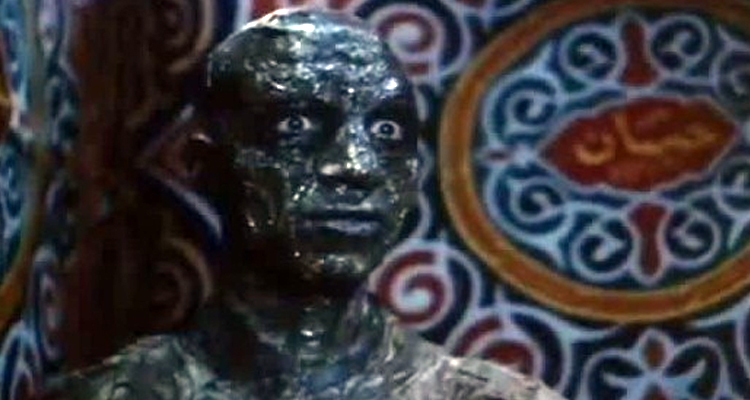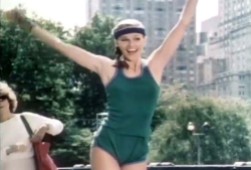Many films focus on the glamour of the modeling industry, but it seems that it’s only the horror genre that concerns itself with its dangers. Movies like Horror of Spider Island and Bloody Pit of Horror have shown us how, time and again, models and those charged with tending to them have been called upon to place themselves in harm’s way, like soldiers at the front. And perhaps no more credible presentation of that reality can be found than in 1981’s Dawn of the Mummy — even if that film also asks us to believe that an American fashion magazine would bankroll a whole crew traveling to Egypt just to shoot dresses that look like old lady nightgowns.
Dawn of the Mummy was produced and directed by Frank Agrama, under the banner of his U.S. based company Harmony Gold. Stateside, both Agrama and Harmony Gold are probably best known for the TV series Robotech, a convoluted hybrid of three different Japanese “mecha” series that, for many American viewers, was their first introduction to Anime. But, before that, the Egyptian born Agrama — who originally went by the name Farouk Agrama — had a long career in Arab popular cinema, directing a series of frothy crowd pleasers that breezily combined a variety of commercial genres.
Agrama’s Arab language films were typically international co-productions, combining funds from countries like Egypt, Lebanon and Turkey to guaranty higher production values while also featuring stars from each in order to garner the greatest returns throughout the region. Dawn of the Mummy follows that model to some extent, boasting participation from both Egypt and the U.S. Some sources also claim that Italy was involved in the production, which would explain the preponderance of Italians among its technical crew –- among them cinematographer Sergio Rubini, who shot a number of notable poliziotteschi and spaghetti westerns, and makeup artist Luigi Battestelli, who worked on most of Lucio Fulci’s horror films.
That last is especially significant, because Dawn of the Mummy is unique in that it resembles Fulci’s Zombie more than it does any proper mummy film that preceded it. This, of course, makes a fair amount of economic sense. Zombie was a huge hit, and having just come out the year before, was still fresh in the minds of moviegoers, while nothing seems to indicate that horror audiences at the time were clamoring to see mummies shuffling around in any form. This way, thanks to its Egyptian settings, Dawn of the Mummy could deliver the visceral horror and gore of Fulci’s film while at the same time placing them in a novel context. Furthermore, those audience members able to suspend their disbelief over the existence of slime oozing, man eating mummies would be rewarded with lots of pretty footage of the pyramids. And models.
While largely shot in Egypt, Dawn of the Mummy takes a brief moment to establish its American provenance in the only way appropriate in 1980: with blaring disco music and a brief scene of a blond, roller skating model in a neon headband having her picture taken in Central Park. Then we have a shot of an airliner in flight accompanied by some economical voiceover exposition from someone I assume is supposed to be one of those hotshot New York talent agents we hear so much about. He’s sending “the best models in town” to Cairo, he tells his unheard interlocutor, while reminding him/her that “this is a top fashion magazine” and that they need “class photos” or they can “kiss this account goodbye”. And then, thus oriented within the gritty milieu of international modeling, we are in Giza, meeting for the first time the diverse cast of talent that has been meticulously handpicked for the task. By which I mean the Blond One, the Brunette One, the Black One, the Clownish Male Model Who’s a Stoner, the Plucky Makeup Girl, and the Pretentious Control Freak Photographer.
But, of course, before all of this, Dawn of the Mummy takes us back three thousand years for a prologue in which we see the entombment of the pharaoh who will eventually be causing so much trouble for our cast. What this pharaoh’s name might be is problematic, because no one member of the cast ever says it the same way twice, and no two members ever seem to agree upon it even momentarily. I believe it is “Sefirama”, but over the course of the film I heard it pronounced as everything from “Sakuraman” to something that sounded like “Surferman”.
Anyway, attending the burial is a priestess played by Egyptian actress Laila Nasr, who loudly informs us that, should anyone in the future breach Surferman’s tomb, he will “RISE AND KILL!”, as will his “army” — just several guys, really, buried along with him — also “RISE AND KILL!” Nasr actually survives into the modern portion of the film to play one of the most sublime ravening hags in cinema history. Whether she is meant to be the same character is unclear, but what is clear is that there still needed to be someone on hand to remind us about how Surferman will “RISE AND KILL!” about a jillion more times.
As will happen, no sooner have we been warned of the consequences of violating the tomb than a jump cut shows us a trio of modern day fortune hunters dynamiting the shit out of it. This trio is lead by Rick, a “crazy American” who is played quite demonstratively by the actor George Peck, giving a manic performance that lands squarely at the intersection between “gold fever” and “coke addled”. It’s sort of a stock phrase to refer to the acting in B movies as “amateurish”, but I’m happy to report that the acting in Dawn of the Mummy instead falls under the category of “professional but bad”, which is better. This seems to happen when you have trained actors who don’t have a grasp on how normal people would behave in any given situation, perhaps because they’ve spent too much time just hanging around with other actors. To be fair, though, none of these performers are helped much by a script which requires one actress, wandering alone in a subterranean tunnel, to suddenly throw up her hands and wail “I’m lost!” to no one in particular. Elsewhere, when word power fails it, that script simply falls back upon repetition for emphasis (“I can’t do it! I can’t do it! I can’t do it!”; “Oh no!, Oh no!, Oh no!”; “I found it! I found it! I found it!”)
Eventually all of the noise that Rick and his crew are making brings them to the attention of the modeling gang, who are overjoyed to have a freshly violated tomb with a real mummy in it in which to photograph the ugly, formless clothes they’ve been charged with immortalizing. Thus do we end up with the tense standoff between unlikeable people in close quarters that has provided the backbone for so many European horror films over the years. Eventually the shenanigans of both will sufficiently angry up the blood of the mummies for them to make an appearance — in the case of the models, not just by fiddling with Surferman’s hidden fortune in gold, but also by strumming acoustic guitars and singing soft rock while smoking doobies around the campfire. No three thousand year old creature, after all, could be adequately prepared for all that the 1970s held in store, and, come the reckoning, a violent reaction would not only be understandable but perhaps a moral imperative.
Now, as I suggested before, the mummies in Dawn of the Mummy aren’t exactly your old man’s mummies — or your grandfather’s, depending on how old you are. Just like a bunch of identically “edgy” comedians, they do things just a little bit differently, so strap in! For starters, the effects crew here took a much more visceral approach to the whole resurrection business, so that, rather than just having the mummies at some point slowly sit up in their caskets, we instead get lengthy shots of gross bodily fluids sputtering and oozing out from between their bandages. And once the mummies have arisen, they’re distinctly gloppy in appearance. Surferman in particular is actually quite creepy looking, with staring eyes and a lean, wraith-like silhouette — not to mention movements that suggest more a canny, silent stalking of his prey than the old school mummy’s traditional stagger.
While no masterpiece, Dawn of the Mummy clearly evidences director Agrama’s skills as a showman — not surprising given his years churning out popular entertainments in the competitive Arab film market. He never aims for anything beyond competence and never falls short of it, sure-handedly keeping everything moving along at an even keel until the final act, at which point he honors his contract with the audience to deliver the expected payoff. That payoff, of course, is a climactic orgy of insane gore designed to satisfy those whose tastes for such had been primed by the Italian zombie films that had come previously. After a very Fulci-esque scene of the mummy “army” rising out of the desert sand in the hazy twilight, the maneaters crash a traditional Egyptian wedding and eat the bride, then move on to tearing into the individual members of the starcast one by one. Beheadings, dismemberment, throat rippings and disembowelments ensue.
Like all great movies made in the 1980s, Dawn of the Mummy ends with a massive explosion. It turns out that no magical incantation or talisman was needed to defeat these particular mummies, but instead just a couple of supermodels hurling sticks of dynamite. It’s a denouement cursory enough to seem like simply the filmmakers’ way of announcing that the budget for prosthetics and fake blood had finally been run through. And if anyone watching was greedy enough not to be satisfied by the previous spectacle of slime dripping mummies repeatedly noshing away at severed hands and the like, it might be cause for complaint. But, like those mummies, whose only mandate was to “RISE AND KILL!”, Dawn of the Mummy’s only justification for its brief 90 minutes on Earth was the lurid depiction of said rising and killing. Rather than gripe, I suggest we instead congratulate it for a job well done and let it rest in peace.
Release Year: 1981 | Country: United States, Egypt, (Italy?) | Starring: Brenda Siemer Scheider, Barry Sattels, George Peck, John Salvo, Ibrahim Khan, Joan Levy, Ellen Faison, Dianne Beatty, Ali Gohar, Ahmed Rateb, Bahar Saied, Ali Azab, Laila Nasr | Screenplay: Frank Agrama, Ronald Dobrin | Director: Frank Agrama | Cinematography: Sergio Rubini, Larry Revene | Music: Shuki Levy | Producer: Frank Agrama


















